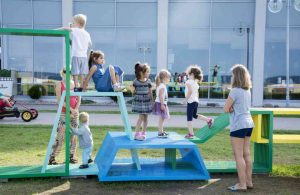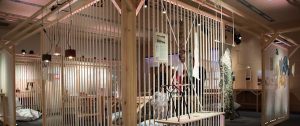Eindhoven, August 2016 – After the successful launch of Intersections in 2015 in Milan, it has had several public commissions. This versatile design for public spaces has proven to function seamlessly inside and outside, permanent and temporary. The installation creates a space encouraging spontaneous actions and stimulates interaction. Now Intersections has a permanent installation in the open air of Gdynia (Poland), as well as a a temporary installation in Copenhagen (Denmark). It took busy professionals, inner city dwellers, pensionados, families with children, and tourists no more than 5 minutes to start intuitively enjoy the many options Intersections offers in public space.
 INTERSECTIONS IN GDYNIA | permanent
INTERSECTIONS IN GDYNIA | permanent
This permanent installation of Intersections, made from powder-coated stainless steel, was placed on the Feliks Nowowiejski Seaside Boulevard in Gdynia, Poland in the summer of 2016. The installation was commissioned by Gdynia Design Center as part of the project ‘Grass to the point’, which aims to create a recreational trail leading through the green squares and parks of Gdynia, in which Intersections will take its permanent place.
The prototype of Intersections (in Polish: Iloczyny) was originally created for Gdynia Design Days 2014, the largest summer festival in Poland. The work was inspired by the modernist architecture of Gdynia, newly built in the modernist period.
INTERSECTIONS IN COPENHAGEN | May – December 2016
This installation of Intersections – Emerging Geometry is displayed in the center of Copenhagen on Kongens Nytorv (The King’s New Square), the largest square in Copenhagen. Intersections can be found just opposite the Hotel d’Angleterre, one of the first deluxe hotels in the world. The installation was commissioned by Metro Copenhagen within the Byens Hegn – Cool Construction program. After Shadow City (2013) and Stairway (2015), this is the third project by Izabela Bołoz that has been commissioned as part of this city project. The project, launched in 2011, facilitates, finances and curates temporary interventions on and along the construction sites, aiming to turn them into a positive and integrated part of the local urban environment.
INTERSECTIONS | the basics
Intersections is an open and versatile collection by Izabela Bołoz launched in 2014. The collection consists of several geometric, modular objects, which can be freely rearranged. As each module slides into the other, like two combs, form and color meet and interweave. Together the shapes create sculptural furniture or installation.
Intersections create friendly and uplifting meeting spaces. Intersections usually remain filled with people performing all sorts of actions. The large frames provide a beautiful spot for selfies and images, both for groups, couples as well as single people. Intersections attract people and invite to sit, relax, search for the best position. People can use the work as a meeting spot, a space for sitting, waiting, chatting.
Izabela Bołoz
Fascinated by human behavior, Izabela Bołoz uses design to engage people. With each piece she invites public interaction, bringing her work to life. Mediating between the human scale and architectural structures, her urban interventions stimulate the imagination, offering new ways of experiencing the ordinary. She brings brings art, architecture and design together in unexpected ways, taking advantage of lost moments and spaces to instil emotion and color in otherwise anonymous environments. With a poetic and subtle approach, her installations are as clever as they are playful; personal havens of wonder, reflection or relaxation for all ages.
Curator Izabela Bołoz created new focus on seas and oceans
 Gdynia / Eindhoven, July 2016 – During the 9th edition of the Gdynia Design Days (Poland) the main exhibition Retrieved was an unfathomed success with professionals, press and the general public. More than 30.000 visitors enjoyed this event. Showcasing the works from 27 international designers, companies, architectural studios and organizations it focused on seas and oceans, a fitting theme for a relatively new harbor city in the north of Poland. Polish / Netherlands based designer and curator Izabela Bołoz curated Retrieved, presenting design concepts that contributed to cleaner oceans, used sea materials in new ways, innovative technological solutions to explore the oceans, as well as educated or increased awareness of the sea and its inhabitants. The event was complemented by workshops, panel discussions, lectures and field initiatives for various professionals, designers, students, inhabitants and tourists.
Gdynia / Eindhoven, July 2016 – During the 9th edition of the Gdynia Design Days (Poland) the main exhibition Retrieved was an unfathomed success with professionals, press and the general public. More than 30.000 visitors enjoyed this event. Showcasing the works from 27 international designers, companies, architectural studios and organizations it focused on seas and oceans, a fitting theme for a relatively new harbor city in the north of Poland. Polish / Netherlands based designer and curator Izabela Bołoz curated Retrieved, presenting design concepts that contributed to cleaner oceans, used sea materials in new ways, innovative technological solutions to explore the oceans, as well as educated or increased awareness of the sea and its inhabitants. The event was complemented by workshops, panel discussions, lectures and field initiatives for various professionals, designers, students, inhabitants and tourists.
Why Retrieved?
Izabela Boloz, curator: “For designers and scientists the sea depths are still unfathomable, barely discovered and understood. The starting question is how to better get to know the sea to be able to wisely use its resources while keeping in mind the protection of the environment. Unfortunately, today one of the most plentiful resources in the sea is plastic. The exhibition has shown to be an inspiration for the creative and wise approach to the sea and water and will also arouse interest in innovative design solutions, not just now but in years to come. We hope Retrieved will travel, so others can experience this friendly to the environment exhibition.”
In this international exhibition, modern technologies allowed the exploration of depths and a more accurate than ever study and analysis of the underwater fauna and flora. Understanding the specifics of the marine environment gives the designer and the viewers the ability to translate observations into functional designs. The collection of works by international design studios, architectural firms, companies and organizations showed the diversity of possibilities for the treatment of the subject. Design is not the only solution as architecture also, thanks to its coexistence with the sea, allows for contact with water. In addition, projects on the basis of open-source software were part of the exhibition, thus enabling the viewers to independently create facilities for research and hence – to better understand the problems of the sea.
Full catalogue and list of designers
Ewa Janczukowicz-Cichosz, Deputy Director of the Pomeranian Science and Technology Park Gdynia: “As the main exhibition of the Gdynia Design Days festival, Retrieved presented an overview of smart and sustainable projects in which the sea plays a major role. It triggered discussions about the condition of shoals, sustainable fishing and the problem of plastic waste floating in the oceans. It showcased what the sea has to offer in the context of alternative materials and fabrics development. We believe that the sea is an interesting proving ground for research for technologists, designers, as well as for children and young people. We need to keep taking closer look at the sea and regain the awareness of its impact on our daily lives.”
Gdynia Design Days
Gdynia Design Days is a yearly festival organized by the Gdynia Design Center. It showcased prototypes and projects that are created specifically in response to the theme of the festival. The core assumption of the event is deeply rooted in themes of the city, urbanity and life of the inhabitants. The festival covered key locations in downtown Gdynia and the grounds of the Pomeranian Science and Technology Park. In 2016 the event was held for the 9th time on the 1-10th July 2016. http://gdyniadesigndays.eu/ | facebook.com/gdyniadesigndays | instagram: @gdyniadesigndays
Izabela Bołoz
Izabela Bołoz is a Polish curator and designer. She studied social science in Wroclaw and Zurich before moving on to study design at Kingston University and Design Academy Eindhoven. In 2011, she established her own studio in the Netherlands. Clients include cultural institutions, local governments and international brands. Her projects are as diverse as her background, ranging from installations in public space, to functional objects and curation of exhibitions. While curating Izabela focuses on telling stories through experience. She is currently a tutor at the Technical University Eindhoven and at the School of Form in Poznan. www.izabelaboloz.com